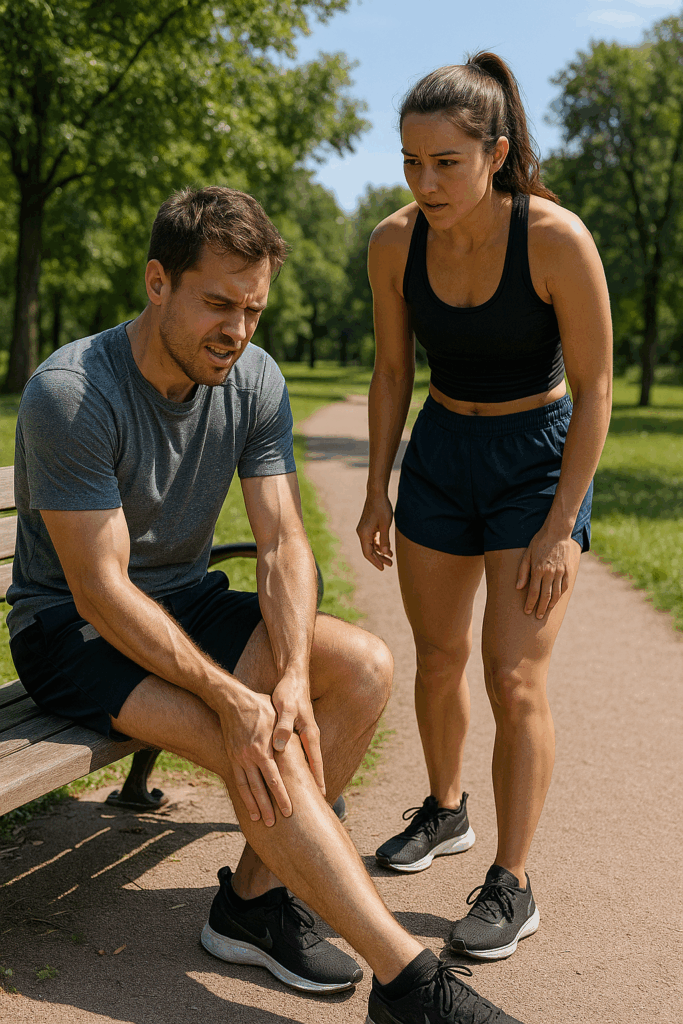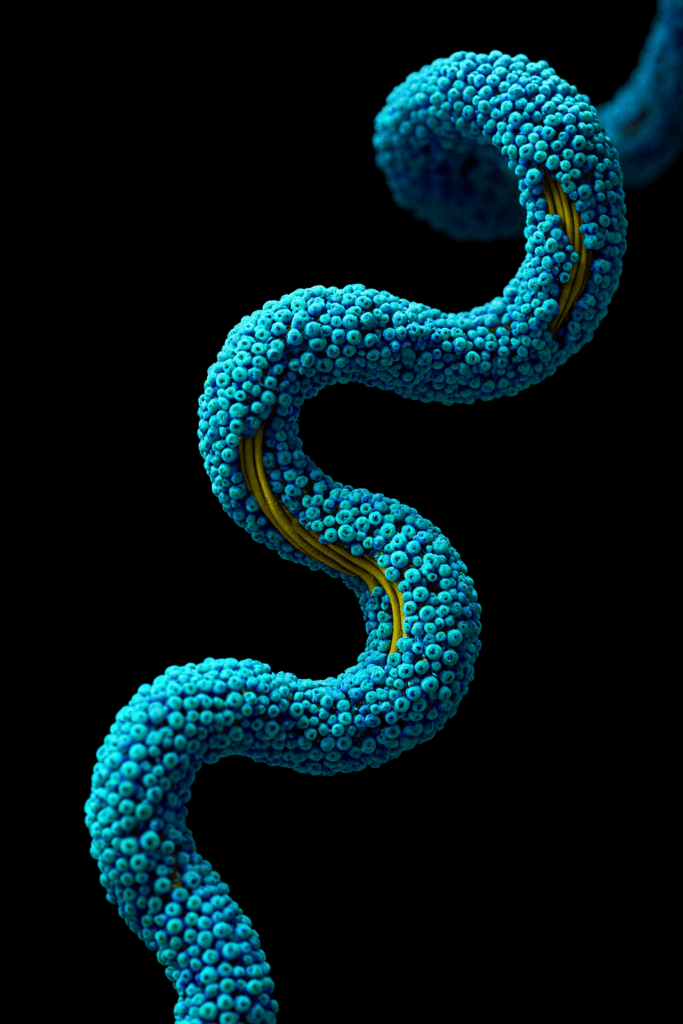Shin Splints: Why They Happen, How to Heal Fast and Stop Them from Coming Back
The Pain Behind the Pace
If you’ve ever felt that sharp, burning ache along the front or inside of your lower leg after a hard run, you’ve met one of endurance sport’s most common overuse injuries: shin splints (medial tibial stress syndrome). They account for nearly 15% of all running injuries and tend to appear during training blocks that include increased mileage, intensity, or hill work.

For athletes over 30, shin splints often strike not because of poor form, but because recovery hasn’t kept pace with workload. The muscles, tendons, and periosteum along the tibia simply can’t rebuild fast enough to match the repeated micro-stress — a concept known as crossing the recovery threshold.
The Real Cause
Shin splints aren’t just “tight calves” or bad shoes. They’re a signal that the bone-tendon interface and the surrounding fascia are under repetitive traction stress. Microtears form in the connective tissue where the soleus and tibialis posterior anchor to the tibia.
In young athletes, these tissues remodel quickly. In older athletes, that turnover slows — the same workload produces more cumulative microdamage. When the balance between microtrauma and repair shifts even slightly toward breakdown, inflammation builds faster than collagen and capillary networks can rebuild.
Why Healing Slows with Age
After age 30, two things decline sharply:
- Growth hormone (GH) output — by roughly 14% per decade.
- Mitochondrial efficiency — by up to 8% per decade depending on activity level.
Together, these reduce your tissues’ ability to regenerate collagen, clear inflammation, and restore ATP (cellular energy). This is why recovery that once took a day in your twenties can take three or four in your forties.
This widening gap is the recovery threshold — the line where training stress exceeds the body’s ability to rebuild. Crossing it repeatedly leads to chronic injury, not because of weakness or poor discipline, but because biology simply can’t keep up.
Traditional Recovery Methods — Helpful, But Often Incomplete
Most athletes with shin splints start with the classic playbook: rest, ice, compression, stretching, massage, and maybe some physical therapy or orthotics. These methods are absolutely valid — they reduce pain, inflammation, and loading stress. For younger athletes with robust regenerative systems, that’s often enough.
But for aging athletes, these same methods can feel like hitting pause instead of fast-forward. Here’s why:
- Rest and Ice quiet inflammation, but they don’t accelerate new tissue formation. You may feel better, but the microscopic tears remain only partially healed — primed to flare up again.
- Physical Therapy and Strength Work help correct imbalances and improve shock absorption, but muscle and tendon cells regenerate more slowly with age, limiting how quickly structural gains appear.
- NSAIDs and Anti-Inflammatories reduce pain and swelling, but they also blunt the prostaglandin and cytokine signaling that triggers tissue repair — meaning faster relief can come at the cost of slower healing.
- Massage, Compression, and Dry Needling stimulate blood flow and fascia mobility but don’t directly affect collagen synthesis or mitochondrial repair.
In short, traditional methods are like clearing debris off a damaged road — they make it usable, but they don’t rebuild the asphalt. Peptides, by contrast, provide the molecular “construction crew” that rebuilds the tissue from the inside out.
For the aging athlete, combining both approaches — traditional recovery to reduce mechanical stress, and peptides to drive cellular repair — represents a more complete, 21st-century recovery model.
The Peptide Advantage
Peptides have emerged as powerful tools for restoring recovery capacity and accelerating repair at the cellular level. For shin splints — which involve tendon, fascia, and periosteal tissue — several have direct, measurable effects.
BPC-157: Microvascular Regeneration and Collagen Repair
Derived from gastric proteins, BPC-157 has shown in animal studies to accelerate tendon-to-bone healing by 200–300%, increase angiogenesis, and reduce pro-inflammatory cytokines like TNF-α and IL-6. For overuse injuries like shin splints, this means faster repair of the microscopic tears anchoring muscle to bone.
Thymosin Beta-4 (TB-4): Cellular Migration and Remodeling
TB-4 is often called the “regeneration signal” peptide. It boosts actin polymerization and mobilizes stem cells to the injury site. Research shows it can speed wound closure by 30–40% and improve collagen organization, making newly healed tissue stronger and more elastic — critical in high-impact loading like running.

GHK-Cu: Remodeling and Anti-Fibrotic Repair
GHK-Cu helps remodel existing scar tissue and restore proper collagen alignment. Studies indicate it upregulates collagen and elastin by 50–70%, while reducing inflammatory gene expression. For chronic shin splints where fibrotic buildup limits flexibility, GHK-Cu may help “reset” the tissue to a healthier state.
Ipamorelin: The Hormonal Catalyst
Ipamorelin is a selective GH secretagogue — it triggers the body’s own release of growth hormone without elevating cortisol or prolactin. Increased GH boosts IGF-1 production, supporting muscle, tendon, and bone repair. Long-term use can restore GH pulse amplitude by up to 40%, amplifying the effects of healing peptides when used synergistically.
Energy Amplifiers: NAD⁺ and MOTS-c
Even with optimal healing signals, tissue regeneration can stall if the cell’s energy system is depleted. That’s where energy amplifiers like NAD⁺ and MOTS-c come in.
- NAD⁺ levels decline roughly 50% by middle age, impairing mitochondrial function. Restoring NAD⁺ via supplementation or precursors like NMN has been shown to increase cellular ATP output by 30–40% and enhance repair signaling through SIRT1 and PARP pathways.
- MOTS-c, a mitochondria-encoded peptide, improves glucose utilization and activates AMP-activated protein kinase (AMPK) — the same recovery pathway triggered by exercise. Research suggests MOTS-c can enhance soft-tissue repair by 30–40% and shorten rehabilitation time for chronic injuries by up to 25% when used with regenerative peptides.
Together, they don’t just repair tissue — they raise the energy baseline so the body can stay on the recovery side of the threshold.
Bringing It Together
For the AgeProof athlete, the goal isn’t to stop training — it’s to train smarter. Shin splints are often a sign that recovery inputs (sleep, nutrition, cellular energy, peptide support) have fallen behind mechanical stress.
A layered strategy looks like this:
- Reduce Load — dial back running volume or swap impact sessions for cycling or pool work for 7–10 days.
- Support Healing — daily BPC-157 and TB-4 micro-injections near the affected area, with GHK-Cu in the evening for remodeling.
- Reignite Hormonal Rhythm — Ipamorelin or CJC-1295 cycles to restore GH pulse timing.
- Rebuild Cellular Energy — stack NAD⁺ or MOTS-c to restore mitochondrial efficiency.
- Re-Load Gradually — as pain subsides, return to impact training with strength and mobility emphasis on calves, anterior tibialis, and intrinsic foot stabilizers.
When recovery is managed proactively — not reactively — athletes can keep pushing training volume and intensity without slipping below their healing threshold. That’s the essence of AgeProof performance: sustaining output while keeping the biology young enough to match it.
References
- Sikiric P. Stable gastric pentadecapeptide BPC-157: healing promoter and modulator of the nitric oxide system. Curr Pharm Des. 2018.
- Goldstein AL et al. Thymosin beta-4 and tissue regeneration: actin sequestration and stem cell activation. Ann N Y Acad Sci. 2012.
- Pickart L, Margolina A. GHK peptide as a natural modulator of multiple biochemical pathways. BioMed Res Int. 2018.
- Jørgensen SB, Steinberg GR. AMP-activated protein kinase and muscle metabolism: implications for recovery and regeneration. J Physiol. 2021.
- Veldhuis JD et al. Age-related decline in pulsatile growth hormone secretion in men: quantitative analyses. J Clin Endocrinol Metab. 2005.
- Gomes AP et al. Declining NAD⁺ induces a pseudohypoxic state disrupting nuclear-mitochondrial communication during aging. Cell. 2013.
- Lee C et al. MOTS-c: a mitochondrial-encoded peptide regulating metabolic homeostasis. Cell Metab. 2015